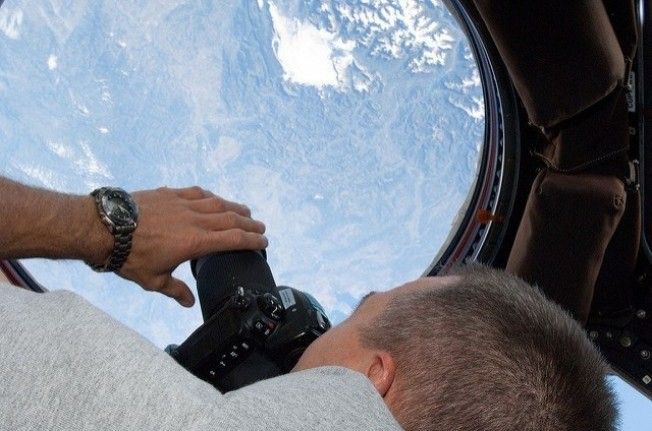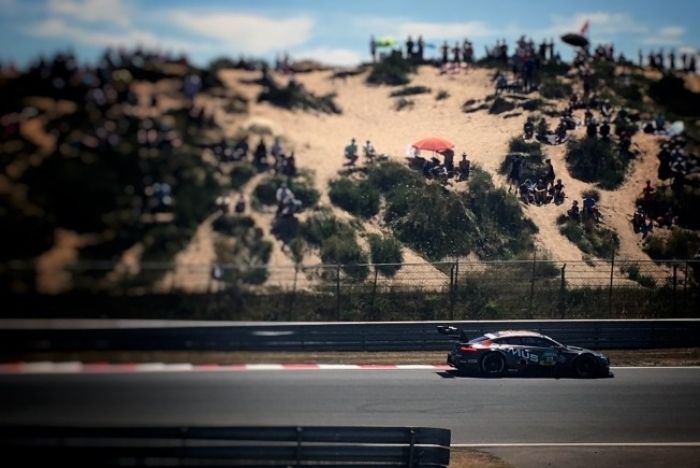Virutas F1Andrew J. Feustel: the fastest pilot in the galaxy
Andrew "Drew" J. Feustel wanted to be a Formula 1 driver. His secondary plan was to be an astronaut, but it was harder. Over time he has traveled more times to space than most superlicense holders have ever stepped on the podium, so his plans worked properly.

Before flying into outer space he was a restoring mechanic for Jaguars from the 50s, he was one of the guys that cured in 2009 the Hubble´s telescope myopia, and it was a mission in which he accumulated almost twenty-one hours of EVA (space walk powered by a flying backpack, like George Clooney's in the film "Gravity").
We're talking not to the fastest pilot in the world, but the fastest in the known galaxy. As we communicate with him, he flies over our heads at about 28,000 kilometres per hour suspended at an altitude of four hundred thousand meters from the Earth´s surface.
Hi, Drew. We all know that you are a Formula 1 fan, how did you start to love this sport?
Hi! I have always been interested in racing of all types. With respect to open wheel racing, and ultimately F1, I think it all started the year I was born. Way back in 1958, Purdue University in West Lafayette, Indiana, began an annual contest called the Grand Prix. This was an event that challenged students to compete with one another in a kart race held in the spring on campus. In 1963, my father participated in the race, and in 1965, the year I was born, my uncle won the race.
That race-winning go kart remained in our family up until a few years ago when we loaned it back to the Purdue Grand Prix Alumni Association. I grew up with that go kart. It had a 90 cc McCulloch kart racing engine on the back and it really moved. As a kid, we would wrap the tires with studded chains and drive the kart on the ice in the winter in Michigan when others were out on ice boats. It was a blast and that is what really got me hooked. There was nothing like drifting a screaming kart on the ice at 50 mph on a clear, crisp day. My father started my brother and I racing motocross at the age of 10. At 13 I was racing BMX, and when I hit my 20s I was racing Enduro karts in the Midwest for about 7 years. I never won the Purdue Grand Prix like my father and uncle, but I did enjoy competing for 3 years. IndyCars and F1 were just a part of my life growing up. And when you grow up in Detroit, Michigan it is difficult to stray too far from motorsports.
Have you seen a race live? Which one was it, where? Can you remember any special detail that you remember on it?
I believe that the first F1 race I saw live was the Canadian Grand Prix in Montreal in 1994. I remember thinking how amazing it was that there was a North American race that was so easy to attend and not far from my home at the time in Kingston, Ontario. I have seen a handful of races since then in Montreal. More recently I was at the first race held in Austin at the American Grand Prix in 2012 and last year we were able to attend the race at Silverstone.
Do you follow the whole F1 season from ISS? How do you do it technically? I guess that Ground Control sends you signal can you explain a little bit about this, the trip the TV signal follows? Is there any delay? Can you see really a race from so high using any optical device?
I have watched every F1 race this season from the International Space Station. Mission Control in Houston sends up a video feed from the TV channel and we see it live. Occasionally we lose the signal from the satellite but typically for no more than 15 minutes. If I am lucky, I can watch an entire race without interruption. On race day, if our orbital path matches with the race location, I can take a photo of the track. Because we are so far away and I only have a 1600 mm lens to work with, it is difficult to see the actual cars on the track, but on a good day with clear skies and a steady hand, I can see them. In many of my pictures it is possible to see vehicles on near-by roads, though I cannot see any details of those cars.

Your make pictures from above this planet at every race course even during the race weekend. Can you tell us how do you make it? Locating the facilities, cameras used, lenses, and so on.
I’m not going to lie, it has proven to be pretty difficult. My colleagues at NASA have supported me with graphic indications on a computer program of when I can expect to fly over a target with precise timing. When the target time arrives, it is necessary for me to float to the window and point the 1600 mm lens (800 x 2.0 magnifier) at the Earth and start looking for my target. This is not easy from 250 miles away.
At nearly 300 miles/minute, there is not much time to get the shot
I can usually just barely catch the shape of the track through the eyepiece and the lens shows an image about 20 track diameters across. In other words, I can fit 20 tracks across the image that I see. So you can imagine that finding a track in the middle of Europe, for example, can be challenging if all you have is the view in the eyepiece. The large landmarks that you can see with the naked eye from space are just gone in the eyepiece. It is not uncommon for me to fly directly overhead a track on a clear day and miss it because I cannot manage to aim the camera at the track in time before the opportunity passes. At nearly 300 miles/minute, there is not much time to get the shot, especially if you have never been there or know anything about how its location looks from 250 miles away.
You have a Bugatti Veyron on your profile at Twitter beside a fighter jet. I´m sure there´s a story behind. Can you tell something about it?
Upon return from my previous space shuttle mission, STS-134, in 2011, my good friend and former editor of Road and Track Magazine, Patrick Hong, arranged the opportunity for me to drive that car. Patrick capitalized on the fact that the Houston Auto Show was a few short weeks away and he knew that Bugatti would have the car in town for the show. He made some arrangements and before I knew it, I was hurtling down Runway 22 at Ellington Field in Houston at 208 mph behind the wheel of the Super Sport with factory test driver Butch Leitzinger in the passenger seat. It was a thrilling experience and a wonderful day to say the least. For the photo shoot, the airport hosts arranged to have the F4 Phantom towed out on the runway for some photos. We all thought that the car and the jet would look good together in a picture.

Can you remember any scene when you really felt emotions on this sport? Probably being a child, on a circuit?
The most memorable moment in my life regarding F1 was a day that many race fans will also remember. It was on May 1, 1994 while watching the San Marino Grand Prix at Imola. I was sitting in our apartment with my wife Indira, in Kingston, Ontario, Canada. On my lap was my 5-day-old son Ari. I felt it was a very special day because it was the first time I would watch an F1 race together with my new son. Sadly, this is the day that Ayrton Senna was killed. I still remember the moment of the crash while watching with my son. That day will always be vividly stuck in my mind.
Are there any other F1 fans onboard? Do you chat about the races results, or with someone down here?
Unfortunately during my time on the space station there were no other racing fans. My Japanese crewmate, Norishige Kanai, did show interest in watching the races with me and I like to think that he learned something about the sport as well. On Earth I do have friends that I like to speak with about the results and how the season is progressing. I think that they enjoy when I share my track pictures with them from space.
Would you like to test a single seater, or even better, a F1 car in the future?
Absolutely! When I was young I always had two dreams in life: I wanted to be an F1 driver and I wanted to be an astronaut. I am very fortunate to have achieved one of my goals in life and I realize now that the other dream to race F1 was really not the right path for me. That said, I still like to go fast and I continue to be passionate about motorsports. Let’s go racing!
The 56th mission commander will be able to watch Formula 1 races on the ground when he returns at the end of September after six months in his space apartment. He´ll be on time to meet the 2018 World Champion. Until then, they say that the most impressive thing about space is the silence, just the opposite of the tracks. Drew will come back to them just to listen, something he can’t do in space.

(Some questions and answers have been omitted because of NASA's internal legal and policy issues. The appreciations to Drew J. Feustel, Megan Sumner of Johnson Space Center's Public Affairs department, and the National Aeronautics and Space Administration, NASA, are only comparable to the size of our galaxy. To all of them stellar thanks).
Fotos: Flickr Andrew Feustel


